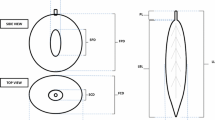Summary
Results from the F1 generation of a set of 6×6 full diallel crosses involving representatives of wild forms, primitive and European cultivars are described. The aim was to compare the systems of genetic control in the parents used in the present experiment with those known to operate in a number of contemporary cultivars. The plant characters analysed were days to and node of first flower, internode length, number of flowers per node and number of ovules per pod.
Different systems of genetic control were found in some of the parents used in this experiment from those characteristic of cultivars in that dominance, and in some cases interaction, have been found to operate. The most extreme difference concerned earliness of flowering which results from an accumulation mulation of dominant alleles in primitive forms, but an accumulation of recessives in those European and North American cultivars so far analysed in detail. Only one of the characters would appear to be under a system of genetic control similar to that of cultivars, node of first flower.
These results are discussed in relation to those obtained from the analyses of previous sets of diallel crosses.
Similar content being viewed by others
References
Cousin, R., 1972. In: Proceedings of the Eucarpia Conference on Peas. (INRA, Versailles, June 1972).
Hayman B. I., 1954. The theory and analysis of diallel crosses. Genetics 39: 789–809.
Links J. L., 1954. The analysis of continuous variation in a diallel cross of Nicotiana rustica varieties. Genetics 39: 767–788.
Krarup A. & D. W.Davis, 1970. Inheritance of seed yield and its components in a six-parent diallel cross in peas. J. Am. Soc. hort. Sci. 95 (6): 795–797.
Marx G. A. & W.Mishanec, 1967. Further studies on the inheritance of ovule number in Pisum. Crop Sci. 7: 236–239.
Mather K. & J. L.Jinks, 1971. Biometrical genetics. Chapman and Hall, London.
Rowlands D. G., 1964. Genetic control of flowering in Pisum sativum L. Genetica 35: 75–94.
Snoad B. & A. E.Arthur, 1973. Genetical studies of quantitatieve characters in peas. 1. A sevenparent diallel cross of cultivars. Euphytica 22: 327–337.
Watts L. E., E.Stevenson & M. J.Crampton, 1970. Inheritance of flowering time in six pea cultivars (Pisum sativum L.). Euphytica 19: 405–410.
Author information
Authors and Affiliations
Rights and permissions
About this article
Cite this article
Snoad, B., Arthur, A.E. Genetical studies of quantitative characters in peas. 2. A six-parent diallel cross of cultivars and primitive forms. Euphytica 22, 510–519 (1973). https://doi.org/10.1007/BF00036649
Received:
Issue Date:
DOI: https://doi.org/10.1007/BF00036649



